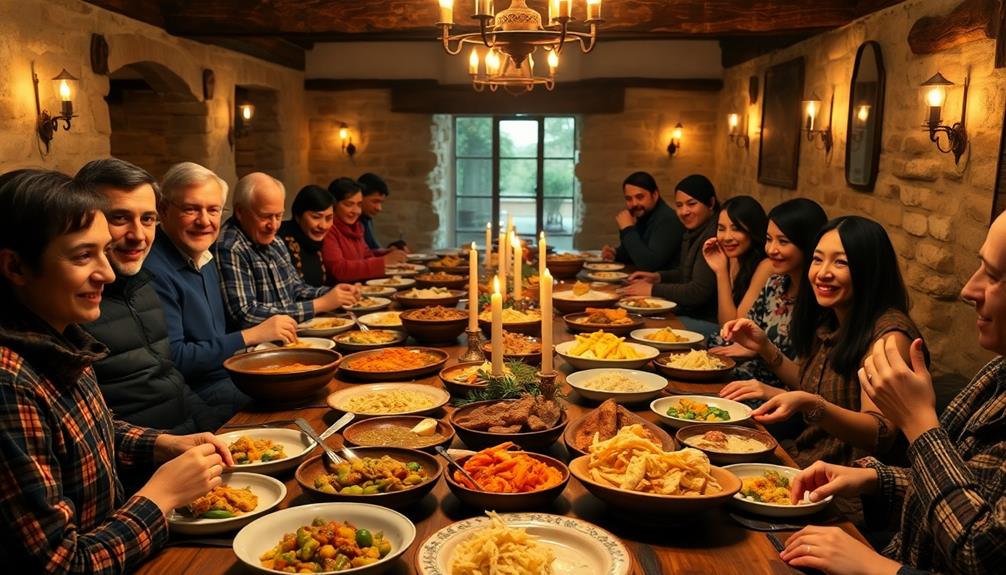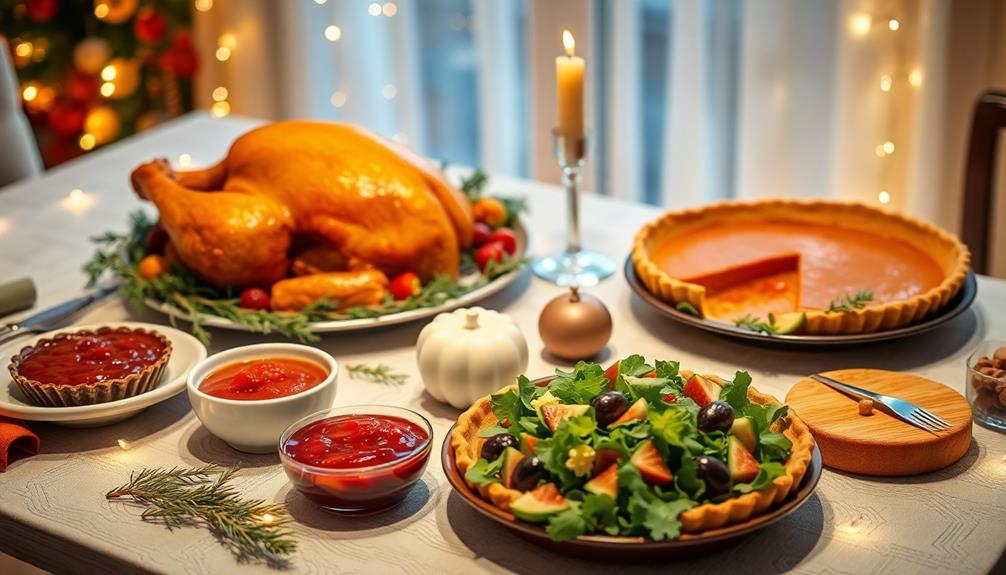Eating together is a joyful experience! It brings laughter, bonding, and lasting memories. When you share meals with family or friends, you boost happiness and health. Here's why dining together matters:
- You share stories, strengthening relationships.
- Eating with others encourages healthier food choices.
- Shared meals can lead to greater joy and less loneliness.
In contrast, eating alone can sometimes feel lonely and less satisfying. It can even affect your mood and health negatively. So, grab your loved ones, enjoy a meal, and create joyful moments! There's so much more to discover about the magic of shared meals!
Key Takeaways
- Eating together fosters social connections, enhancing happiness and life satisfaction compared to solitary meals, which can lead to feelings of loneliness.
- Shared meals encourage healthier food choices and increased food intake, while solo dining is often linked to poorer dietary habits.
- Communal eating creates a festive atmosphere, promoting conversations and bonding, whereas eating alone can diminish the joy of the dining experience.
- Solitary eating is associated with higher rates of depression and lower quality of life, particularly among older adults.
- Regular shared meals can alleviate stress and create lasting memories, strengthening relationships and improving overall mental health.
Definition of Communal Eating

Communal eating, often referred to as communal dining, is all about sharing meals with others to enhance social interaction. When you gather around a table with friends or family, you create special moments filled with laughter and joy.
Shared meals are more than just food; they're a chance to build relationships and connect with those around you. For instance, enjoying a flavorful dish like Caldeirada can spark conversations about regional cuisines and culinary traditions.
Here are some reasons why communal eating is so wonderful:
- Brings People Together: When you sit down to dine with others, you strengthen your bonds and create lasting memories.
- Encourages Conversations: You get to chat, share stories, and enjoy each other's company, making every meal an adventure.
- Creates a Fun Atmosphere: Dining together is often filled with smiles and excitement, turning a simple meal into a festive occasion.
- Fosters Understanding: You can learn about different cultures and traditions through shared meals, making each dining experience unique.
In today's world, many restaurants even have big tables for communal dining, inviting everyone to join in the fun.
Historical Significance of Shared Meals

Shared meals have played an essential role in human history, shaping social structures and cultural practices across various societies. When you think about it, eating together brings people closer, creating bonds that last a lifetime.
From ancient Rome to modern dining trends, communal meals have always been significant. In many cultures, specific dishes are prepared for shared occasions, like Thanksgiving turkey sandwiches that highlight the spirit of togetherness and the joy of leftovers.
Here are some fun facts about the historical significance of shared meals:
- Ancient Rome: Shared dining was key for religious and social traditions.
- Native American Potlatch: Celebrated community and reinforced social ties.
- Thanksgiving: A joyful occasion that highlights togetherness.
- Religious Rituals: Events like the Agape feast and Passover Seder foster spiritual connections.
- Modern Trends: Restaurants now promote communal dining, showing that the joy of eating together never fades.
As you enjoy meals with family and friends, remember that these moments are more than just about food. They're about love, laughter, and connection.
Sociological Perspectives on Eating

Eating together is more than just a meal; it's a chance to build friendships and share joy!
When you gather around the table with family or friends, you not only enjoy tasty food, such as Chilaquiles or Elote, but also create happy memories that can boost your mood.
Let's explore how these shared moments can brighten our lives and strengthen our connections!
Commensality and Social Bonds
Many people underestimate the profound impact that commensality has on social bonds and overall well-being. When you gather around the table and share a meal with family or friends, you create connections that nourish not just your body but your spirit too.
This is especially true with traditional dishes like squash casserole, which often bring families together during gatherings. Research shows that 76% of folks believe shared meals strengthen relationships. Eating with others even boosts your food intake by 60% compared to solitary eating!
Here are some wonderful reasons to enjoy meals together:
- Stronger Social Bonds: Sharing food creates lasting connections.
- Increased Happiness: Communal meals often lead to higher life satisfaction.
- Better Eating Habits: Eating together can improve your food choices.
- Fun and Laughter: Meals with friends are filled with joy and shared stories.
- Psychological Benefits: Eating with others can lift your mood and enhance well-being.
Impact on Mental Health
Research increasingly highlights how communal meals can profoundly influence mental health. When you share meals with others, it creates joy and strengthens bonds. On the flip side, eating alone often leads to feelings of loneliness and can increase depressive symptoms. Let's look at some key points about how eating habits impact mental health:
| Eating Alone | Social Eating |
|---|---|
| Higher rates of depression | Lower stress levels |
| Poorer dietary behaviors | Better quality meals |
| Lower life satisfaction | Greater happiness |
| Increased feelings of loneliness | Enhanced social connections |
| Skipped meals | Shared experiences |
Eating alone can lead to skipping meals or not getting enough nutrients, which can worsen your mood. In contrast, social eating brings people together, making meals more enjoyable. Research shows that those who dine with others report feeling happier and more satisfied with life. So, next time you gather around the table with family or friends, remember that you're not just sharing food—you're sharing happiness! Embrace those moments, and you'll nourish both your body and your mental health. Additionally, sharing a meal can help combat feelings of loneliness and foster a sense of belonging, which is essential for emotional well-being. While the psychology of comfort eating often highlights the soothing effect of indulging in certain foods during stress, eating with loved ones provides a healthier and more meaningful way to find solace. These shared experiences create lasting memories, turning simple meals into powerful tools for connection and care.
Trends in Modern Dining Habits

Have you noticed how many meals you eat alone these days? With almost half of adults dining solo and many evenings spent without company, it's clear that solo dining is on the rise!
This shift emphasizes the importance of seasonal ingredients, making dishes like Nettle and Potato Soup a perfect choice for those cooking for one.
But don't worry, communal eating is still loved by many, and the joy of sharing a meal with friends or family can bring a special sparkle to your day!
Solo Dining Trends
Solo dining has become a significant part of modern eating habits, with approximately 46% of meals among U.S. adults now enjoyed in solitude.
You might find it surprising that the average adult eats alone about 7.4 times a week! While some may shy away from eating alone, it can actually be a delightful experience, especially when you take the opportunity to indulge in a favorite dish like Mushroom Masala or try your hand at making Gobi Manchurian.
Here are some fun ways to enjoy your solo dining moments:
- Choose Your Favorite Food: Cook or order what you love without worrying about others' preferences.
- Create a Cozy Atmosphere: Light a candle, or play your favorite music to set the mood.
- Use Technology: Enjoy a show, or scroll through your social network while you eat.
- Practice Mindfulness: Focus on each bite and savor the flavors, making your meal a special time.
- Experiment with New Recipes: Solo dining is a perfect chance to try new dishes you've always wanted to make!
Even though communal meals have their charm, eating alone can be a joyful break.
Embrace it, and let solo dining become a revitalizing part of your life!
Communal Eating Popularity
As communal dining experiences grow in popularity, restaurants are increasingly designing large tables that encourage interaction among diners, fostering a sense of community.
Imagine sitting at a big table, sharing delicious food like a loaded baked potato with friends and family. This is what communal dining is all about!
Research shows that many people still eat alone during the week. In fact, about one-third of evening meals are consumed solo. That's a lot of missed opportunities for fun!
While you might enjoy eating alone, think about how much happier you could feel while sharing meals with others. Studies reveal that social eating can boost happiness and strengthen friendships.
Events like The Big Lunch, which had over 7.3 million participants last year, bring people together for joyful, shared meals.
When you gather around a table, you can talk, laugh, and enjoy food intake together, creating memories that last a lifetime.
Eating Alone: Prevalence and Patterns

Many people find themselves eating alone, a trend that's become increasingly prevalent in today's society. Did you know that around 30% of U.S. households consist of just one person? This contributes to the rise of solitary dining!
On average, you might enjoy about 7.4 meals alone each week, and a whopping 46% of eating occasions happen in solitude. Traditional dishes from various cultures, such as Muamba De Galinha in Angola, highlight the communal aspect of eating, making solitary dining feel even more isolating.
Older adults particularly feel this pattern, with 14.6% reporting they often dine alone. It's also interesting to note that solitary dining is more common in urban areas, where many men and women eat together less than once a month.
Eating alone can influence your dietary behaviors, sometimes leading to skipped meals or lower caloric intake.
Here are some fun tips to make solitary dining more enjoyable:
- Play your favorite music while you eat.
- Try a new recipe just for yourself.
- Set a lovely table, even if it's just for you.
- Enjoy a good book or movie during your meal.
- Take a moment to savor each bite!
Mental Health Impacts of Solitary Eating

The isolation that comes with eating alone can greatly impact your mental health. When you often find yourself dining solo, it can lead to feelings of sadness and loneliness. Studies show that eating alone is linked to higher rates of depression. This means that those who enjoy meals with others tend to feel happier!
Incorporating fun, themed meals like Graveyard Taco Dip during gatherings can enhance the joy of shared dining experiences. Here are some important points to reflect on:
- Men eating alone are found to have a greater chance of feeling depressed compared to those who share meals.
- If you eat together less than once a month, your health and happiness might suffer.
- Older adults who eat alone often experience a lower quality of life. Social isolation can make things even tougher.
- Eating alone might also lead to not getting the right nutrients, which can make you feel foggy or down.
Eating together can be a joyful experience! It's a wonderful way to connect with family and friends, share stories, and create lasting memories.
Nutritional Differences in Eating Settings

Eating together not only fosters social connections but also greatly influences your nutritional choices. When you gather around a table with family or friends, the meals can become more than just food; they become shared experiences that can boost your diet quality.
For instance, enjoying traditional dishes like Kue Putu or Dadar Gulung during communal meals can enhance not only the flavor but also the nutritional value of your diet. Eating alone often leads to poorer dietary behaviors, like skipping meals or munching on less nutritious snacks.
Here are some exciting benefits of communal meals:
- Increased Food Intake: You might eat about 60% more food when dining with others!
- Better Choices: Sharing meals with healthy eaters can inspire you to make smarter food choices.
- Variety of Foods: Communal meals often include more meat and veggies, which are great for your health!
- Social Facilitation: Eating together makes food more enjoyable and encourages you to try new things.
- Healthier Habits: When you dine solo, it can lead to lower caloric intake and unhealthy eating patterns.
Social Dynamics of Mealtime Interactions

While enjoying a meal together, individuals often engage in dynamic interactions that can greatly impact their eating behaviors and choices. Eating together with family members or friends not only makes meals more fun but also encourages everyone to eat more.
Studies show that when you dine with others, you tend to consume more food, especially if they're enjoying tasty dishes!
The social dynamics at the table really can shape what you eat. If you're surrounded by healthy eaters, you might find yourself choosing better foods, too.
Plus, when you share a meal, it helps reduce feelings of loneliness, especially for older folks. Eating alone often feels less satisfying and can lead to unhealthy habits.
Here's how mealtime interactions matter:
- Boosts food intake: Eating together increases what you consume!
- Improves diet quality: Good company promotes healthier choices.
- Fosters connections: Shared meals strengthen relationships.
Benefits of Communal Dining Experiences

Sharing meals with others offers a wealth of benefits that extend beyond just satisfying hunger. When you engage in communal dining, you strengthen social bonds and boost your overall wellbeing.
Research shows that people who frequently share meals report higher happiness and life satisfaction. Plus, it's more fun!
Here are some fantastic benefits of dining together:
- Stronger social connections: Eating with friends and family builds lasting relationships.
- Better eating habits: You're likely to eat more fruits and veggies when dining in groups.
- Increased food intake: You might eat up to 60% more when you enjoy meals with others!
- Improved mental health: Regular communal meals can help combat loneliness and reduce stress.
- More joyful experiences: Sharing meals creates happy memories and laughter.
Frequently Asked Questions
What Is the Psychology of Eating Together?
Eating together creates a sense of belonging, boosts your mood, and enhances social bonds. You'll likely enjoy more food and feel happier, as shared meals often lead to deeper connections and greater life satisfaction.
Is It Better to Eat Alone or With People?
When you share a meal, you're not just filling your stomach; you're creating connections. Eating with others often boosts your mood and encourages healthier choices, while dining alone can lead to missed opportunities for joy.
What Is the Philosophy of Eating Together?
The philosophy of eating together focuses on the social connections formed during shared meals. It highlights how these experiences strengthen relationships, enhance happiness, and promote a sense of belonging, enriching both personal and communal lives.
What Is the Psychology Behind Eating Alone?
When you dine alone, your plate becomes a mirror reflecting solitude. You might feel the weight of isolation, leading to skipped meals and unhealthy choices. Yet, you may also find comfort in your own company.
Conclusion
Eating together is like throwing a party for your stomach and heart! It's not just about the yummy food; it's about laughter, stories, and making memories that sparkle like confetti. When you share a meal, every bite feels like a hug. Sure, eating alone can be cozy sometimes, but nothing beats the joy of a crowded table filled with family and friends. So, grab your loved ones, fill your plates, and let the feasting fun begin!









